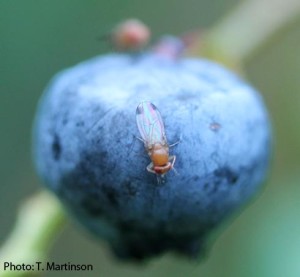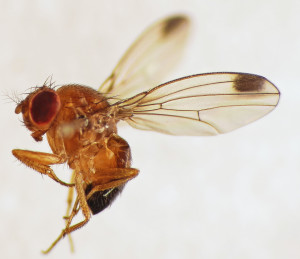The Spotted Wing Drosophila (Drosophila suzukii), a relative newcomer in the United States, is a pest of Asian origin that attacks many different stone fruits including grapes. It was first spotted in California in 2008, quickly spreading up the Pacific coastline by 2009 and making its way across the United States by

Photo by Flickr user NY State IPM Program at Cornell University (https://www.flickr.com/photos/99758165@N06/16286847043/)
hitching rides with humans since they don’t fly very far on their own.
Basically, what happens is that the female Spotted Wing Drosophila (SWD) lays her eggs in the fruit, and then the developing larvae eat and otherwise do their business on that fruit, resulting in significantly reduced quality for wine making or anything else for that matter.
Compared with other fruits, however, some research has shown that grapes aren’t the best host for SWD survivorship, and that if grapes are already healthy and unscathed, only 0-9% of the larvae actually survives to adulthood. However, grapes that have been damaged by birds, disease, or something else have been shown to survive for a longer period of time, lay more eggs, and transmit Acetobacter bacteria into the grapes, all contributing to reduced grape quality and an overall economic loss for the vineyard.
A new study published in the Journal of Economic Entomology aimed to look into the effect of Spotted Wing Drosophila infestation on grape quality further, by looking at the infestation rates in vineyards in two different locations and to determine how various physiological traits of the grapes may or may not contribute to infestation rates by Spotted Wing Drosophila.
Brief Methods
Experiments were performed at vineyards in Trento Province, Italy, and Willamette Valley, Oregon during the 2011 through 2013 vintages.
Two separate experiments were performed: no-choice observational experiments, and choice observational experiments.
The grape varieties studied in Italy were: Chardonnay, Yellow Muscat, Traminer, Pinot Noir, Teroldego, and Schiava. No insecticides had been used on the grapes.
The grape varieties studied in Oregon were: Chardonnay, Pinot Gris, Pinot Noir, and Merlot.
All grapes were checked for SWD infestation prior to experimentation and only those SWD-free were used.
Penetration resistance was determined by pressing a 2-mm blunted needle into a grape until the point of penetration.
No-choice:
Italian Study: 4 female and 1 male SWD were placed into a plastic box with holes on the shortest sides (2 of them). 10 berries were placed into the box with the flies and allowed to interact for 24 hours. After the 24 hours, the flies were removed and all grapes that contained SWD eggs were stored and monitored daily for adult emergence. The number of eggs per grape were counted and recorded.
This experiment was repeated 4 times for each grape variety during 10 weeks from veraison to harvest. The same experiments were also performed on blueberries and raspberries for comparison to grapes.
Oregon Study: Clusters of five grapes were placed into screened containers and were either artificially damaged by a scalpel or left completely intact. Half of the containers contained damaged grapes, while the other half were left intact. 3 males and 2 female SWD were introduced into the containers and left alone with the berries for 72 hours. After the 72 hour time period, flies were removed and eggs were counted.
Grapes with eggs were stored and monitored daily until adult emergence.
Penetrating resistance (i.e. how easy it is for the fly to get into the grapes) and sugar content for each grape variety were measured.
This experiment was repeated for all grape varieties studied.
Choice:
Italian study: Choice experiments were performed in the field, giving the SWD a choice between the grapes or going someplace more appealing.
SWD egg deposition and larval development was monitored on a weekly basis from veraison to harvest.
150 fully intact berries on 10 clusters and 10 vines were observed per grape variety.
Grapes with eggs were stored and monitored daily for adult emergence.
General SWD presence in the vineyard area was monitored by baiting them with a special sugar-vinegar-water mixture in a 1 liter red bottle. These traps were monitored weekly from veraison to harvest.
Oregon study: Field tests were performed by randomly collecting at least 25 grapes from 18 unsprayed Pinot Noir vines and checked for SWD presence.
Results
No-choice:
Italian study:
- There were significant differences between the 6 grape varieties studied in Italy in regards to the number of eggs per grape berry, and the susceptibility of egg laying during different times of the growing season.
- No eggs were laid on the earlier season grapes (i.e. closest to veraison) while the most eggs were laid on the grapes closest to harvest time.
- The greatest number of eggs was laid on the Schiava grape variety, followed by Chardonnay and Pinot Noir.
- Time needed for adult emergence was significantly longer (3.9 days) in grapes compared with blueberries and raspberries.
- Average adult development time on blueberries and raspberries was 9.2 days while average adult development time on grapes was 13.1 days.
- There was a strong statistical separation between grape varieties with high infestation (Schiava, Chardonnay, Pinot Noir) and those with low infestation (Traminer, Yellow Muscat, Teroldego).
Oregon study:
- Brix levels at harvest for the grape varieties studied varied between 17.5 (Pinot Noir) and 18.8 (Pinot Gris).
- The greatest number of eggs was laid on the Pinot Gris variety.
- Damaged grape berries showed higher egg laying rates than fully intact grapes.
- A greater number of adults emerged from eggs laid on damaged grapes compared with fully intact grapes.
Choice:
Italian Study:
- In 2012, traps in the vineyard indicated that SWD presence increased from veraison to harvest, with the first eggs on Schiava grapes noticed about half way through this ripening period.
- Infestation increased steadily over the last three weeks prior to harvest on grapes with penetration resistance levels lower than 40cN (Schiava).
- In 2013, Pinot Noir grapes were noted to have egg deposition after harvest when penetration resistance levels reached close to 40cN.
- No eggs were found on grape berries with penetration resistance levels higher than 40cN (all but Schiava).
Oregon Study:
- 5 SWD adults per cluster were observed compared with 6.5 fruit fly (D. melanogaster) adults per cluster.
Conclusions
The results of these experiments suggest that egg laying by the Spotted Wing Drosophila increases from veraison to harvest, with the highest infestation rates occurring just prior to and during harvest. This infestation rate corresponds with a decrease in penetration resistance of the grape throughout this same time period. There also appeared to be a trend where more eggs would be laid on grapes with higher Brix levels.
Also, the structural integrity of the grape skins also appeared to influence egg laying by Spotted Wing Drosophila. If the grapes were fully intact, the numbers of eggs present were very low. On the other hand, if the grapes were damaged in some way, the numbers of eggs present were significantly higher. This indicates that having already damaged grapes is a possible vector for increased Spotted Wing Drosophila infestation rates in the vineyard.
![Photo By John Tann from Sydney, Australia (Drosophila suzukii on glass) [CC BY 2.0 (http://creativecommons.org/licenses/by/2.0)], via Wikimedia Commons](http://www.academicwino.com/wp-content/uploads/2015/07/spotted-wing-drosophila-on-glass-the-academic-wino-300x169.jpg)
Photo By John Tann from Sydney, Australia (Drosophila suzukii on glass) [CC BY 2.0 (http://creativecommons.org/licenses/by/2.0)], via Wikimedia Commons
In summary, these results suggest that grape damage results in the greatest chance of Spotted Wing Drosophila infestation in the vineyard, though for fully intact grapes with penetration resistance levels 40cN or lower, infestation is also possible. So, if you have damaged grapes or grapes with relatively weak skins, your vineyard may be at higher risk for SWD infestation than another vineyard.
Compared with other species like the more common fruit fly (D. melanogaster), Spotted Wing Drosophila infestations are not as common in places like Oregon, however, it is important to understand how and when they might occur to help reduce the amount of damage that might be done in the vineyard and ultimately to the bottom line.
This is, of course, a relatively limited study, and therefore much more work should be done prior to adopting sweeping vineyard-wide preventative measures. For current information regarding SWD prevention, you may refer to this article here on Capital Press.
Source:


4 comments for “Influence of Damage and Skin Structural Integrity on Infestation of Spotted Wing Drosophila in Wine Grapes”